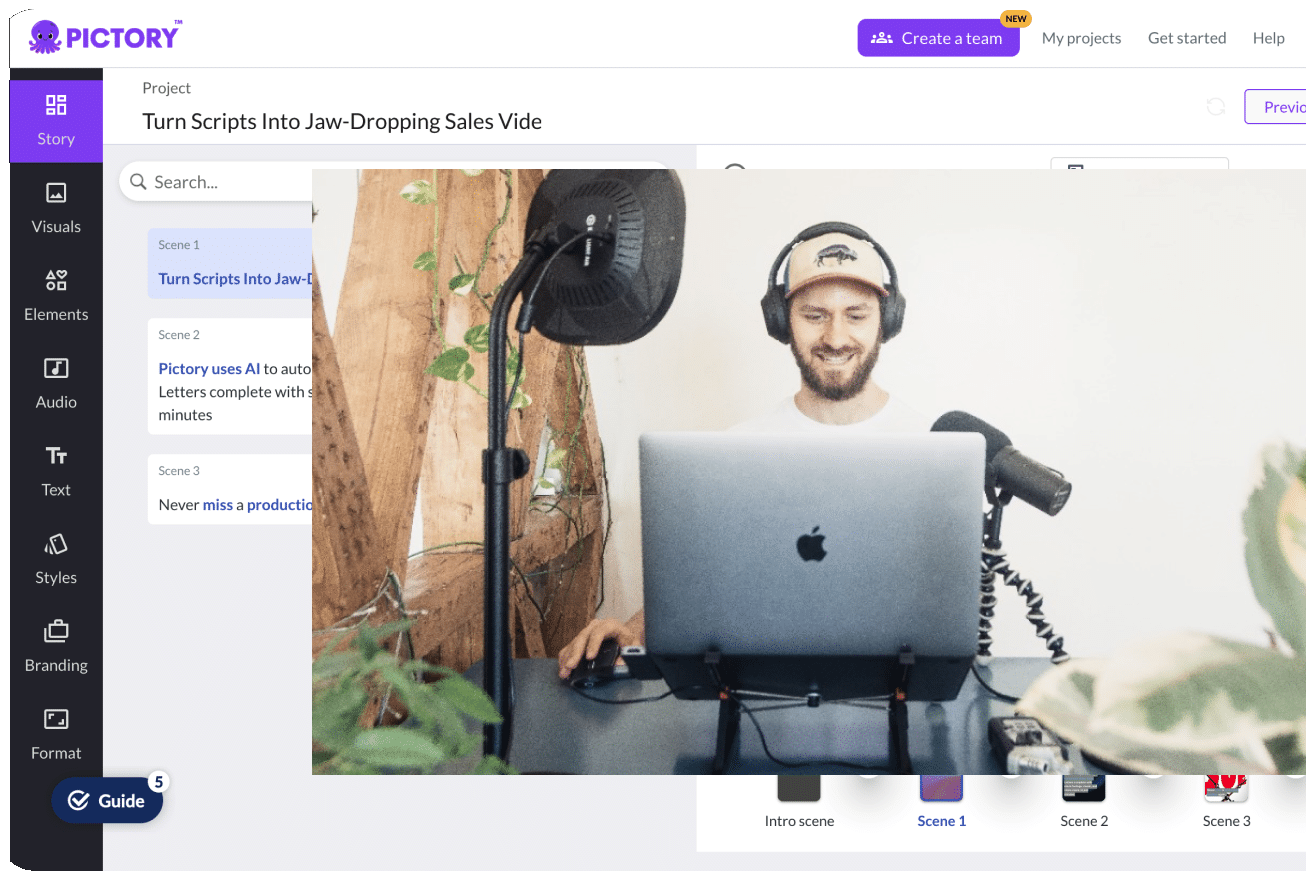When it comes to content marketing, there is no single, perfect way to do it – only the perfect way for you and your business’s goals.
Every business needs a content marketing strategy to help prioritize resources and marketing efforts, but also to ensure that what you’re putting out online is in line with your top business objectives.
Understanding Content Marketing
Before we start setting goals or building a strategy, let’s get clear on what exactly we’re talking about when we discuss “content marketing”.
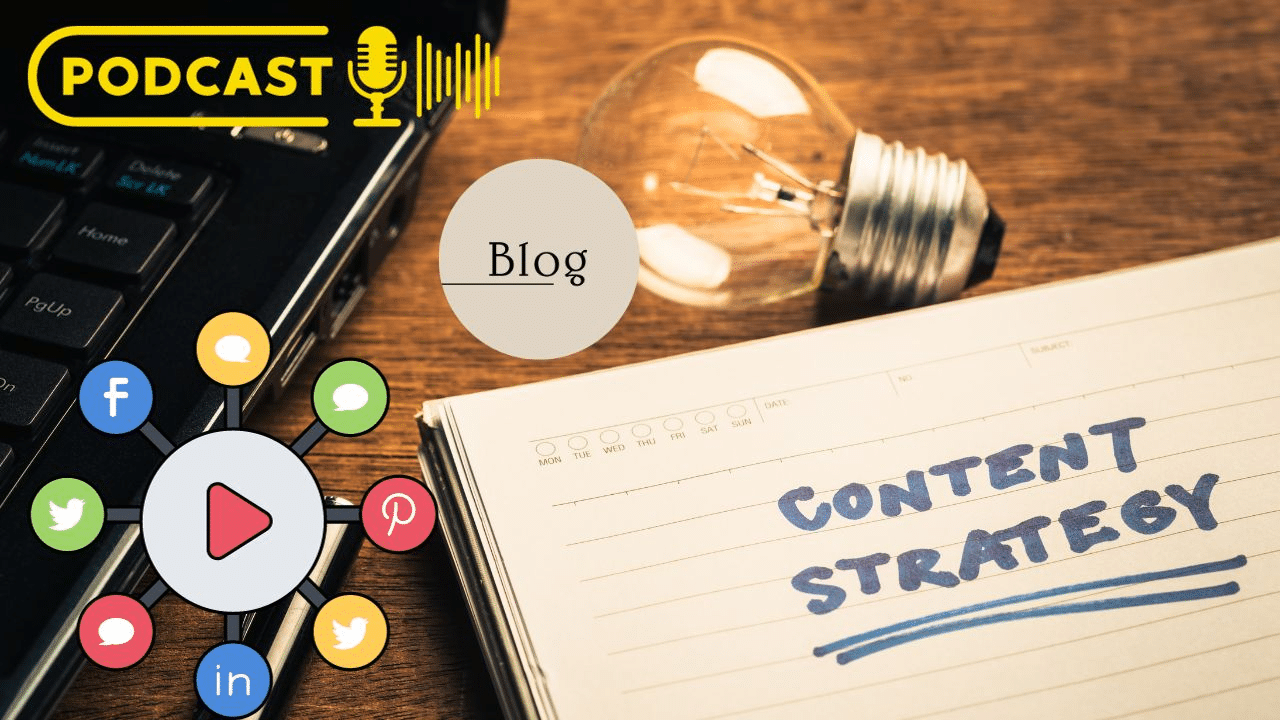
Content Marketing Basics
At its most basic level, content marketing is simply the creation of online content such as blogs, videos, and social media posts, that are used to promote a business or gather interest in it.
The “marketing” aspect of things is usually done indirectly and not as explicitly as say a billboard advertising a product.
The Evolution of Content Marketing
Content marketing has evolved hugely in recent years.
SEO and online articles or blogs are used to dominate content creation.
And while they’re still a highly valuable aspect of any strategy, the expanded social media landscape has pushed content marketing to shift course many times over.
The explosion of short-form video content has perhaps provided the biggest shift, but the growing popularity of podcasts has been yet another factor in the changes content marketers have seen.
As each social platform changes, so too have content marketing strategies in order to keep up with audiences.
The focus of content marketing has also changed over the decades and become increasingly focused on generating brand awareness and community rather than just clicks.
The result has been many brands prioritizing content that doesn’t just provide information but is attention-grabbing enough to stop people mid-scroll so that they’ll engage and share the content with others.
The Role of Goals in Content Marketing
Goal setting is an important part of success for most business efforts but what specific importance does it hold for content marketing?

Let’s dig in:
Why Goals and the Goal-Setting Process Matters
Content without clear objectives guiding it is simply content.
It may be very engaging and interesting, but it’s unlikely to fill a marketing gap if it isn’t goal-led.
Having clear business objectives to guide content creation is what turns that content into a business tool, rather than just another nice thing on the internet.
The Connection Between Business Goals and Strategy
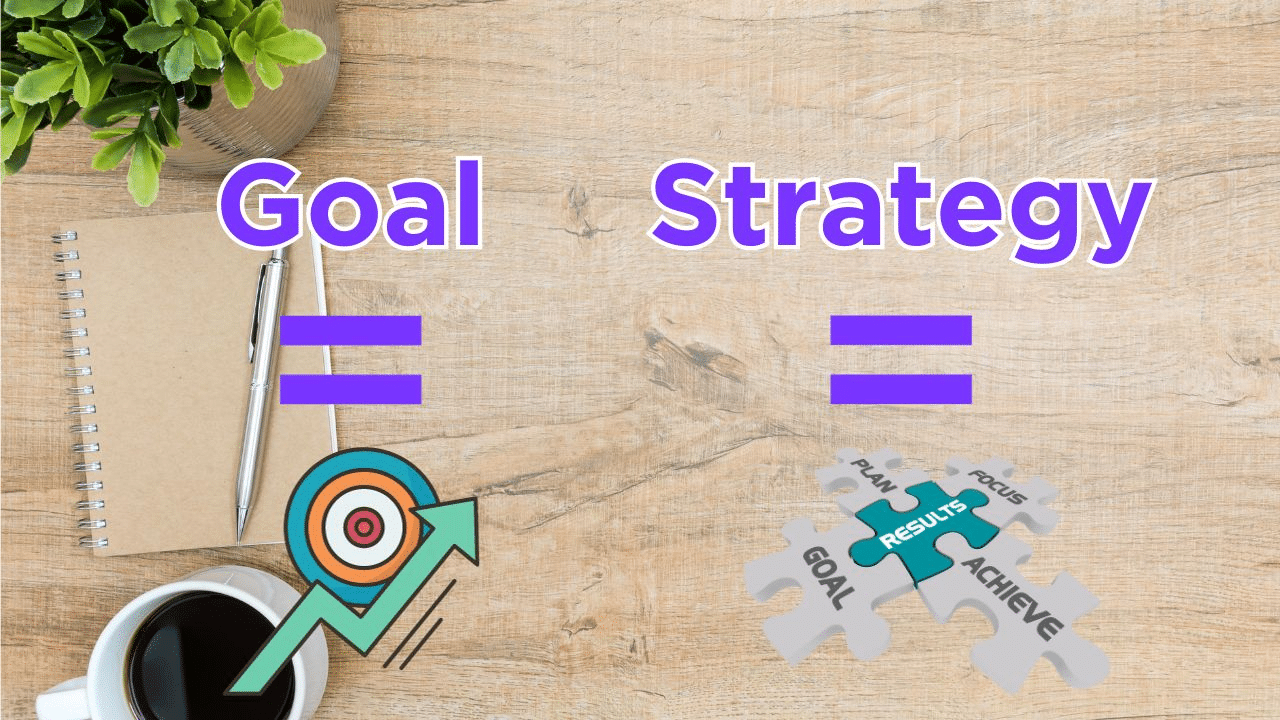
A goal refers to the desired outcome whereas a strategy is the map that lays out how that outcome will be reached.
A strategy without a goal is like a road trip without a destination: meandering and with a high risk of getting lost on the way.
That’s why it’s so important to start any content marketing strategy with a session in which a business clarifies its specific goals.
It makes it much easier to draw up a strategy and to see how their online content can be shaped to achieve those outcomes, from the platforms they focus on to the exact style of content shared.
Types of Content Marketing Goals
A company’s goals can be quite general but nailing them down for content marketing requires a little more focus.
Here are some of the major types of content marketing goals and two examples within each that businesses can reference:
Awareness Goals
Awareness-based goals are all about building more attention around a brand and attracting new people to it.
This is especially important for newer brands or any businesses trying to expand their audience reach.
Building Brand Awareness: Building brand awareness can simply be about attracting more followers or views on content.
But it can also be judged on how frequently content is being shared or accessed outside of existing customers and followers.
However, this goal should always be accompanied by a clear picture of the target audience a brand is after.
Increasing Website Traffic: Attracting traffic is another “awareness” content marketing goal as it’s centered on getting new people onto your site.
Engagement Goals
Attracting new people and clicks to your business is one thing, but engagement goes beyond that.
It’s important to look at how people are interacting with the content itself and whether it’s providing value to them, beyond just simply introducing your brand or products.
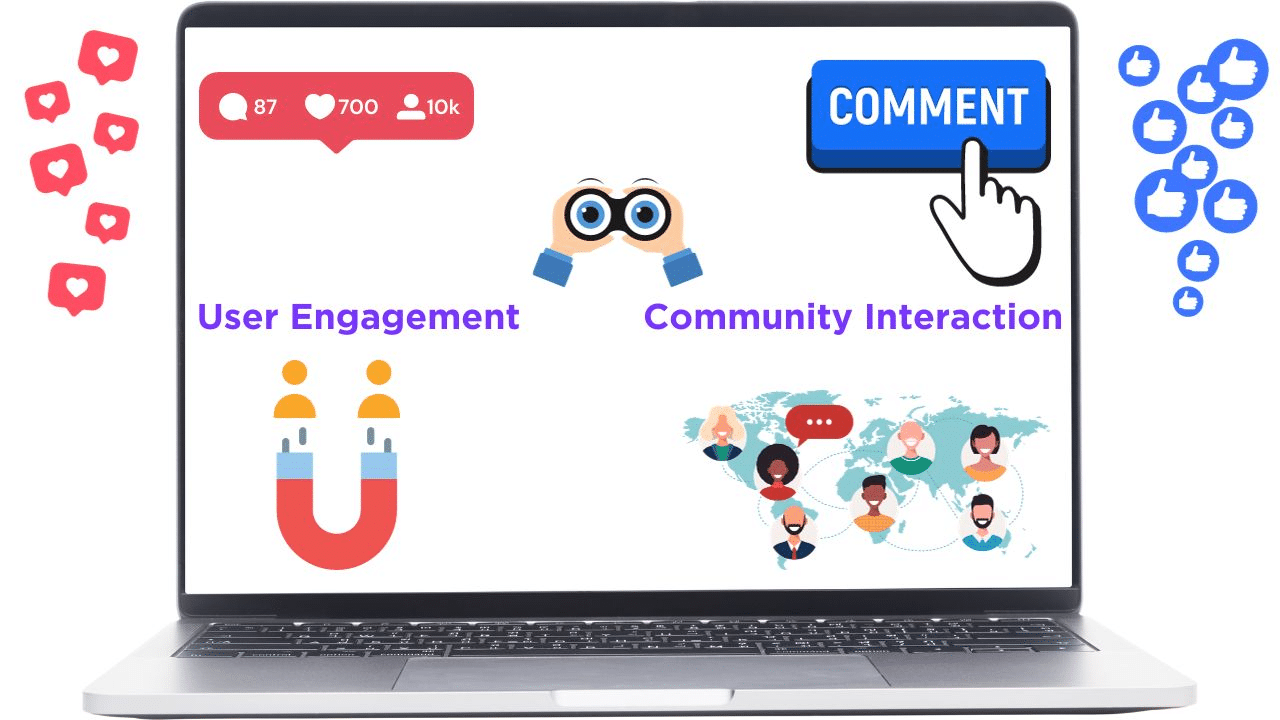
Enhancing User Engagement: User engagement can come in a myriad of forms, from likes and comments to shares, views, and time spent on a web page.
Any time someone takes an action based on your content, that’s considered engagement.
Fostering Community Interaction: Engagement isn’t simply about how an audience interacts with a brand directly but how that audience interacts with each other in places like comment sections.
Carefully crafted content can help start a conversation that goes beyond the immediate offerings of a brand and instead builds discussion and community around it.
This kind of engagement is hugely valuable as it furthers brand awareness and brand loyalty.
Conversion Goals
Conversion is one of the most crucial marketing objectives to pay attention to because it’s the area that focuses on leads, attracting new customers, and increasing sales.
A successful “conversion” is any time a customer completes the desired action as evident in a business’s CTA (call to action).
For example, if a business includes the CTA “click to shop” in a promotional newsletter and the customer clicks as requested, that counts as a conversion.
Boosting Sales and Revenue: The most popular kind of conversion that features in company goals is a purchase conversion.
It’s a relevant goal for any business for whom boosting sales and revenue is their chief content strategy goal.
It can apply to new or existing customers.
Generating Leads: Lead generation is slightly different from something like a purchase conversion because it’s focused primarily on encouraging new site visitors or followers to convert into customers.
It could also be considered an awareness goal as it’s focused on gaining interest amongst potential customers.
But lead generation has the added goal of increasing sales by the end.
Retention Goals
Boosting customer retention is a business goal that many return to and for good reason.

In most industries the top 5 businesses have a customer retention rate of 94% which points to just how significantly this aspect aligns with business success.
Content marketing efforts can easily be channeled toward this goal, through two main avenues:
Customer Loyalty and Repeat Business: The first side of any retention goal is simply to keep customers coming back.
Repeat customers are far easier and cheaper to reconvert because there’s a groundwork of familiarity already laid out.
Reducing Churn Rate: Churn rate refers to the rate at which customers stop returning to a business.
This side of a retention goal is less about bringing people back and more about focusing on what might be preventing their return.
Churn rate can impede company growth if not attended to.
And often quality content can be used to discern what’s making it difficult to retain existing customers and target them to return.
Qualitative Goals
Some content and business goals aren’t easy to quantify, but that doesn’t make them any less relevant for business success.
These include:
Building Thought Leadership: This goal is all about building a sense of expertise and authority in a particular field of industry.
Enhancing Customer Relationships: Customer satisfaction and relationships are hard to measure but are nonetheless vital to any brand.
Tailoring Content Marketing Goals to Your Business
None of the content marketing goals mentioned will have any measurable impact on a business unless they are tailored to the business’s exact needs.
Identifying Your Unique Business Needs

Identifying your unique set of needs can start with several things.
But it will primarily be shaped by prior performance, your company’s strengths and weaknesses, the nature of the product or service you’re selling, and where you currently stand with your audience base.
Case Study: Pickford Tech – A Fictional Business
To illustrate how to set content marketing goals based on business objectives, we’re going to use an example from a fictional company: Pickford Tech.
Pickford Tech is a mobile app that helps users decide what to wear for the day.
Users upload 8 items (because the mascot, Pickford the octopus, has 8 arms) and the app turns it into a coherent outfit.
Pickford Tech has only launched very recently and for now, needs to focus on building awareness around their brand.
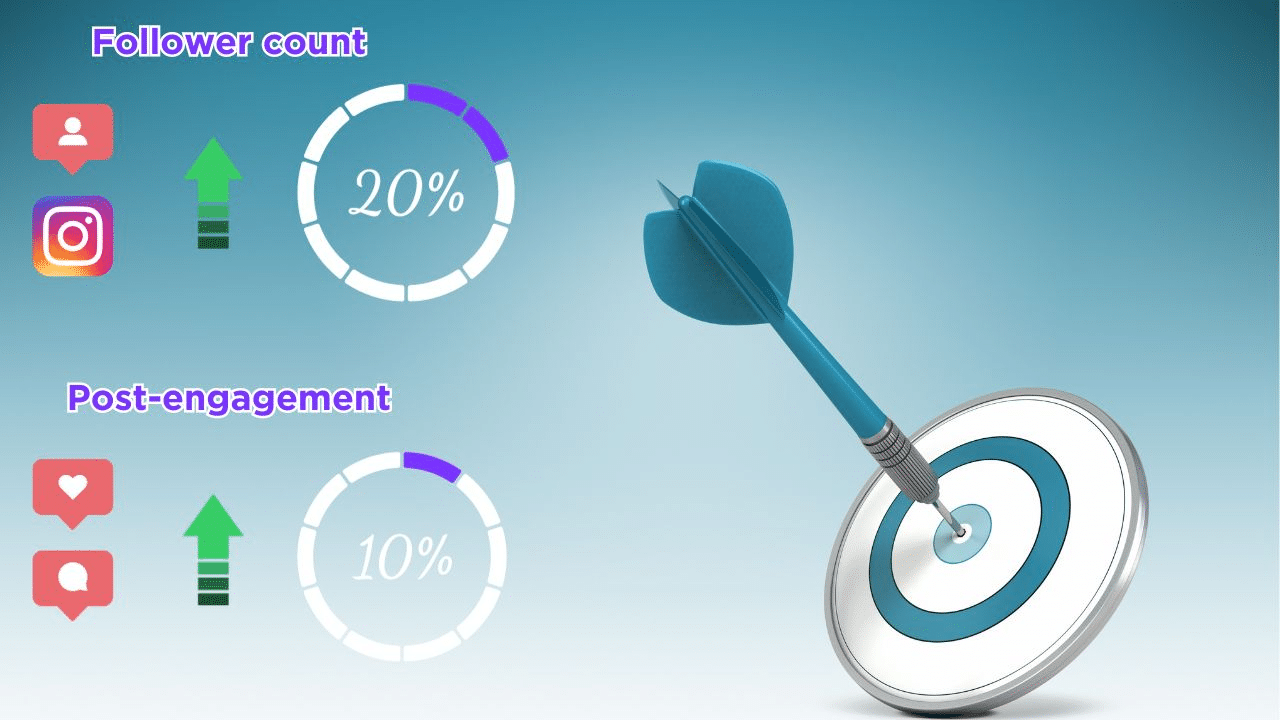
They could, for example, set a goal for a 20% increase in follower count on their Instagram page in 3 months.
They could also incorporate engagement goals, and look for a 10% post-engagement increase on their social content.
A unique need that Pickford Tech has when it comes to its awareness campaign is the specificity of its target audience: working people between the ages of 30 and 55 who are too busy to decide what to wear in the mornings.
Their app has many strengths that make it particularly attractive to this kind of audience, but their online content needs to be tailored to this in order for them to meet their marketing objectives.
Setting SMART Content Marketing Goals
Once you’ve distilled your business’s unique set of needs into content strategy goals, it’s important to check that they meet a tried-and-true approach to business goals: SMART goals.
This mnemonic acronym refers to a set of criteria intended to help anyone develop measurable and realistic goals.
Let’s run through it quickly:
Specific: A mistake many make when they set goals is not making them specific enough.
If it’s they’re too broad, it not only confuses focus but makes the goal harder to measure.
Measurable: Make sure there is some metric that you can use to judge your success.
Measurable goals allow businesses to see if what they’re doing is having an impact.
Achievable: Whatever your business goals are, they must be practical and realistic.
Set a goal that’s too high and it will only cause frustration and failure.
Relevant: There is no point chasing business goals that don’t relate to your mission statement.
Keeping every business goal relevant ensures that when you achieve them, that success is also relevant.
Time-Bound: Keeping business goals time-bound simply means putting a deadline on things.
Limiting the goal to a specific period of time increases focus and makes it far easier to measure as well.
As the example I provided earlier:
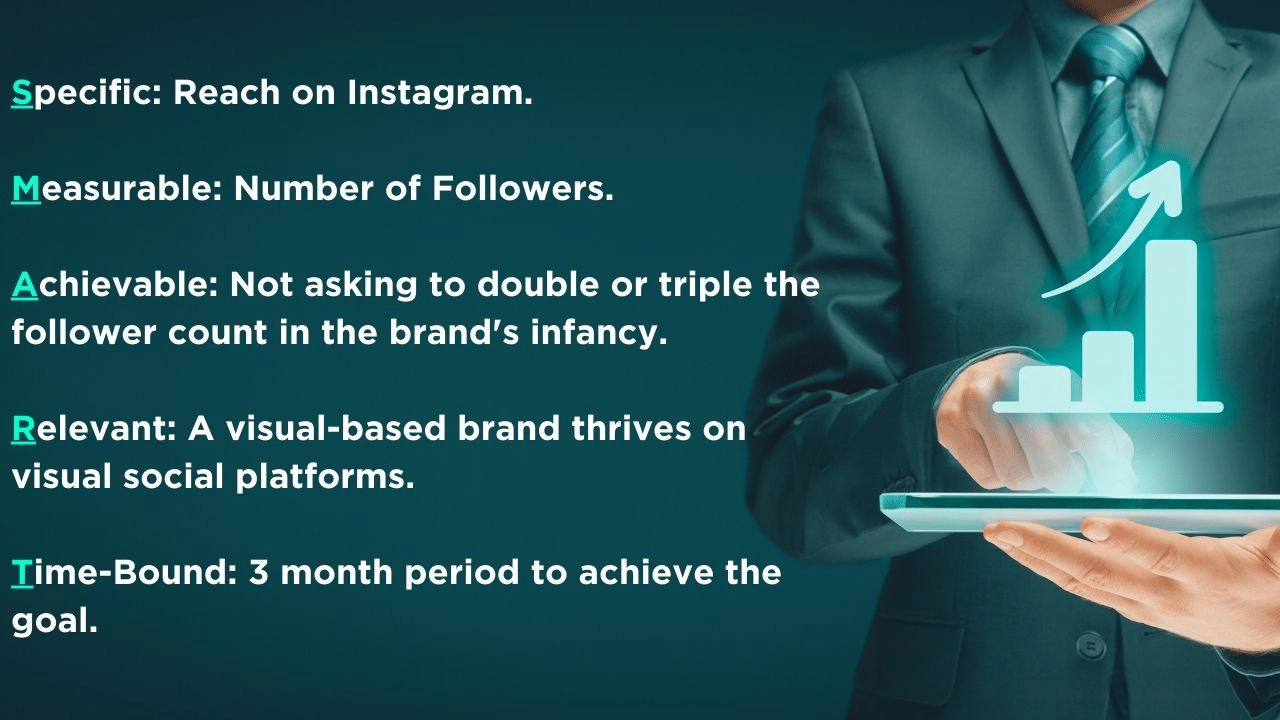
Specific: Reach on Instagram.
Measurable: Number of Followers.
Achievable: Not asking to double or triple the follower count in the brand’s infancy.
Relevant: A visual-based brand thrives on visual social platforms.
Time-Bound: 3 month period to achieve the goal.
Aligning Marketing Content with Your Goals
Knowing how to set business goals is one thing but creating engaging content that aligns with them?
That’s a whole different area of decision-making to consider …
Creating Goal-Centric Content
Creating business-forward content that aligns with company objectives starts with ensuring that every team member, be they creative or sales is on the same page about what the ideal outcome of that content should be.
From there, the job is about creating content that funnels current and potential customers toward that.
Mapping Content to the Customer Journey
With a clear vision of what the right direction is, business leaders then need to map out the customer journey.
Something that works for most marketing objectives is to use the classic marketing funnel:
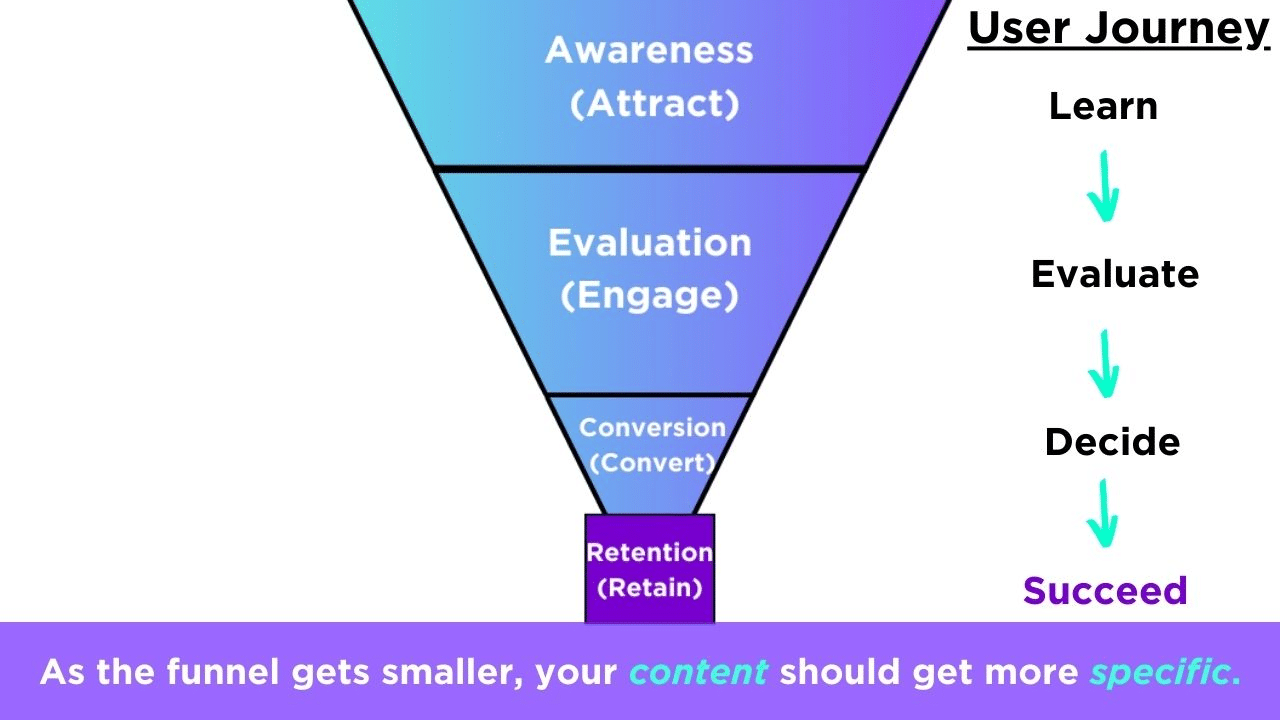
This approach encapsulates the basic journey that most customers take with a brand.
Aligning content with goals is also about aligning it with the specific parts of the customer journey that a brand needs to target.
For example, with Pickford Tech, the company is still in the awareness phase and needs to push content that will encourage followers to consider downloading their app.
Tracking and Measuring Content Goals
An issue many have with their business goals and content strategies is knowing how to track progress.
Here’s what you need to know about content marketing metrics and tracking whether you’re meeting business objectives.
Key Performance Indicators (KPIs)

Many different KPIs can be used to measure the success of a content marketing strategy.
Their relevance, however, depends on what it is you’re trying to track.
Here are some KPIs to use, divided by the content strategy goals they best illustrate:
Conversion and lead generation: Click-through rate, cost-per-lead, number of new customers or leads, how long it takes to convert leads, and revenue generated.
Engagement and awareness: Social media likes, comments, shares, messages, and follower growth.
How much traffic does the business website attract, how long they spend on the site, and what the click-through rate is from your content?
Customer retention: Measure how many purchases are from repeat customers and if they’ve clicked through using any of your content.
Tools for Monitoring Content Marketing Success
Success can be measured using all manner of online tracking and analytics apps.
Most social apps and web hosts, such as Shopify, have their own built-in insights that can be used.
Popular tools for this also include HubSpot, Hootsuite, Mailchimp, Mixpanel, and even Google Analytics.
Case Study Update: Pickford Tech’s Progress
To measure progress when it came to Pickford Tech’s awareness campaign, the team primarily looked at followers and basic engagement increases on social channels.
They also broke this down further by looking at the age distribution of the audience they had attracted and were happy to see that it closely aligned with their target market.
As their goal was based on the number of followers, it was an easy KPI to measure.
They could also look at when follower count increased and what content was published around that time, to see what content works for their business strategy.
The Role of Content Types in Goal Achievement
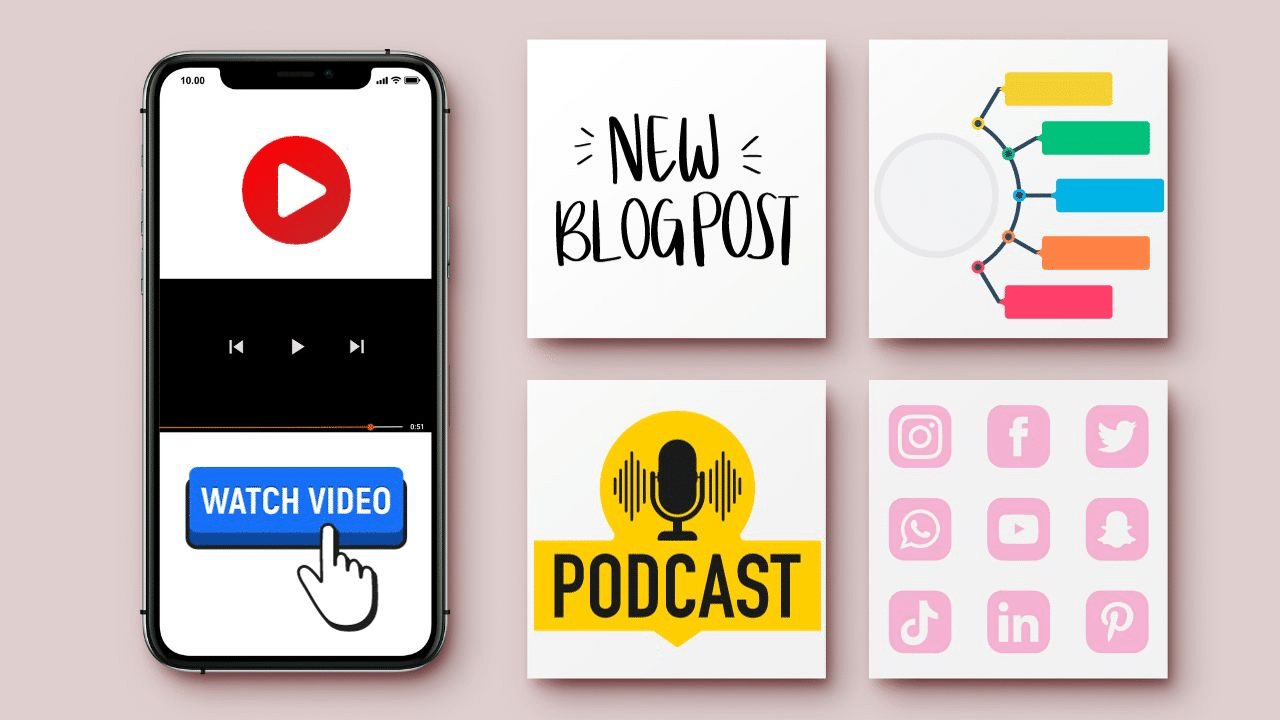
With so many content types and platforms available, it’s important to note how each can serve different business goals and content strategies:
Blog Posts: Blog posts are great for improving website rankings on search engines so that businesses appear organically in people’s searches.
For that reason, they help with awareness goals but are also effective for conversion.
Videos: The nature of online video, especially short-form content on Instagram and TikTok, is particularly well suited for attracting new customers and audiences, as well as boosting overall engagement and community.
Infographics: Infographics are a highly effective and visually engaging tool to bridge knowledge gaps.
They can help with conversions and sales, as well as drawing back existing customers.
Social Media: Social platforms in general help with most content and business goals.
But social media is especially effective at community building.
Social platforms are one of the few ways customers can interact directly with brands through their content, and vice versa, which allows better relationships to form.
Choosing the best ones for your business to be on depends on your goals and how best the different platforms can serve them.
Read our article on Finding which Social Media Platform is Best for Your Business for more help.
Email Marketing: Most people will only sign up for email marketing once they’ve already visited a site or made a purchase.
As such, it’s best suited for retention and conversion goals.
Crafting a Content Calendar
A great way to stay on top of business objectives and create consistently valuable content is to craft a content calendar.
Planning Content Around Goals
Plan your content calendar around time-sensitive goals so that the content is ready to hit certain goals at the points it’s most needed.
This is especially true if you want high-quality content to go up in conjunction with new launches etc.
Maintaining Consistency in Your Content Strategy

Creating exceptional content takes time and planning.
A calendar helps ensure that content teams have enough time to keep quality consistent and to post consistently enough to meet company goals.
Revisiting and Adjusting Goals
The thing about goals for your business is that will always need to be revisited over time and adjusted to ensure relevancy.
Adapting to Changing Business Needs
Business needs can change for a variety of reasons.
It may have to do with feedback from current customers, input from other business leaders, or even reaching certain goals on your content strategy that then opens the doorway for new ones.
Case Study Update: Pickford Tech’s Adjustments
Initially, Pickford Tech focused primarily on awareness and engagement but even as their follower count grew and they saw great interaction from people online, their app downloads didn’t see the same numbers.
As such, they decided to shift course and focus the attention of their marketing and sales team to prioritize conversion goals instead.
This included content that would convince online followers to download their app and subscribe for exclusive paid content, such as discount codes for their favorite clothing brands.
The Evolution of Pickford Tech’s Content Strategy
What started as an awareness-based approach, turned into a content strategy that needed to nail down conversions instead.
Pickford Tech’s strategy shows two important things that every business should keep in mind:
Always re-visit existing content and goals and check if they’re still relevant to where your business needs to go.
Try not to get too single-minded in any goal.
Focusing only on awareness can mean that actual sales or download conversions are neglected.
Ready, Set, GOAL!
Content marketing goals are primarily about translating business objectives into realistic, actionable steps as they relate to a brand’s connection with its customers.
Having to set goals may seem tiresome but they are highly effective at not only making content marketing efforts more successful, but also inspiring teams to do more and better.
There are so many different types of content to make and it can seem easy to get lost in it all but the best way to stand out is by focusing on what it is that makes your business unique and the goals that most pertain to your success.
That way you don’t just get great results from your content marketing strategy, you get the results that mean the most to you and your business.
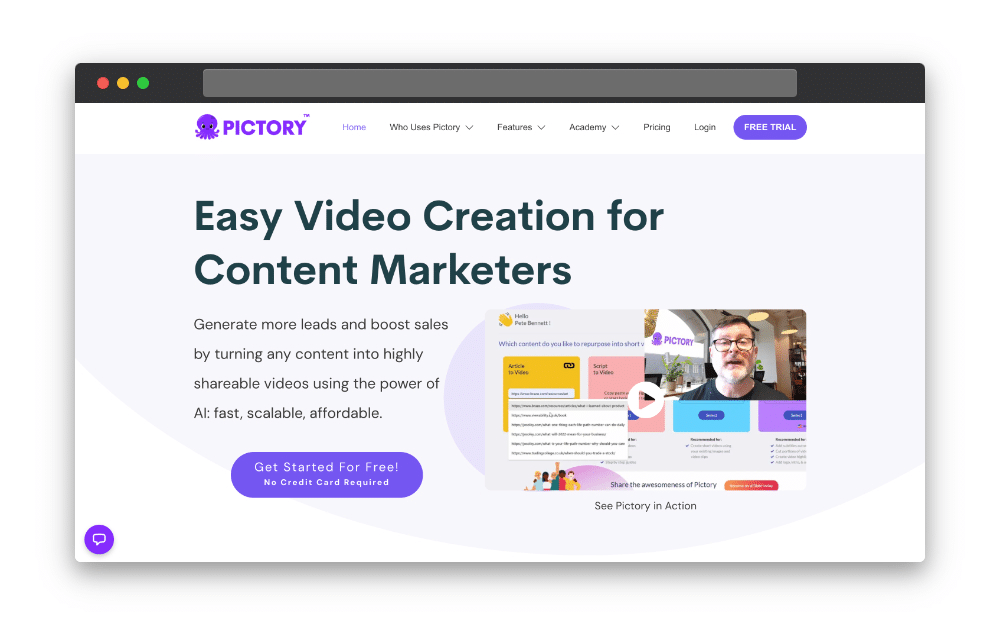
Sign up or upgrade your Pictory account today, to explore our video editing features that will transform your content marketing strategy.
And with our Hootsuite integration, publishing and tracking your content has never been easier!





